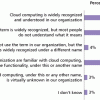Strategic advice to leverage new technologies
Technology is at the heart of nearly every enterprise, enabling new business models and strategies, and serving as the catalyst to industry convergence. Leveraging the right technology can improve business outcomes, providing intelligence and insights that help you make more informed and accurate decisions. From finding patterns in data through data science, to curating relevant insights with data analytics, to the predictive abilities and innumerable applications of AI, to solving challenging business problems with ML, NLP, and knowledge graphs, technology has brought decision-making to a more intelligent level. Keep pace with the technology trends, opportunities, applications, and real-world use cases that will move your organization closer to its transformation and business goals.
Recently Published
In my last Advisor, I discussed the characteristics that you should expect from an enterprise application architecture (see "Are You Ready for New Media?" 27 April 2011). This week, I'll explore two fundamental concepts of the application architecture: layers and tiers.
This on-demand webinar presents an overall enterprise architecture that incorporates the many different perspectives of the cloud, addresses the range of issues, and describes a framework to govern what can be moved to the cloud, what should not be moved, what IT should do proactively, what the business can do on its own, and what it must coordinate with IT.
According to our research, interest in using predictive analytics by end-user organizations is very high. More than half of organizations say they consider predictive analytics strategically important. Yet use of the technology, although increasing, is still fairly limited. So what are the biggest issues standing in these organizations' way? Cost? Although always an issue, it is by no means the biggest.
Software Cloud Computing: Part I -- Programming for Everyone?
Do you know how electricity is produced? You probably know that it has something to do with turbines and magnets, but don't worry about it; most people don't really know. How about water? How does it get to your kitchen sink? Let's be honest; you don't really care, do you? Well, neither do most people. They just want it to be there when they need it.
Let's face it. We are at the end of Moore's Law. The common version of this law says computing power doubles every 18 to 24 months. Advances in silicon engineering have made this possible. But this natural law of silicon is driven by the fundamentals of materials science and the laws of physics. Unless we find a way to change the gravitational constant of the universe or surpass the speed of light, we are likely to face another four decades of computing unlike the past four decades.
Businesses are faced with ever-increasing complexity, competition, and cost pressures. Vendors espouse new products and "silver bullet" solutions, but more often than not, they fall short of expectations, and worse, add to the complexity of IT challenges. Yet there is hope for getting a handle on this complexity and finally addressing the challenge of business/IT alignment. The approach is not based on a new product or technology but on an architectural foundation that brings the complexity of IT into focus from a business perspective.
Businesses are faced with ever-increasing complexity, competition, and cost pressures. Vendors espouse new products and "silver bullet" solutions, but more often than not, they fall short of expectations, and worse, add to the complexity of IT challenges. Yet there is hope for getting a handle on this complexity and finally addressing the challenge of business/IT alignment. The approach is not based on a new product or technology but on an architectural foundation that brings the complexity of IT into focus from a business perspective.













